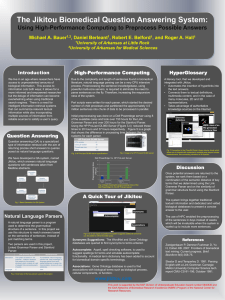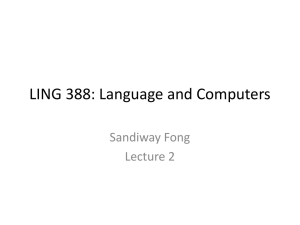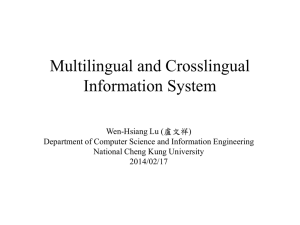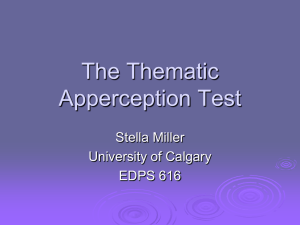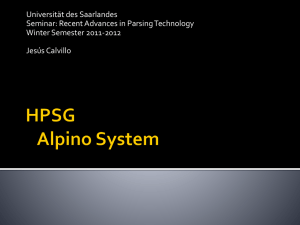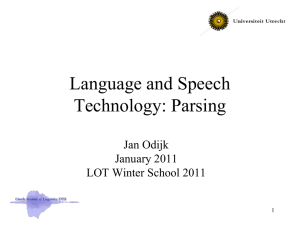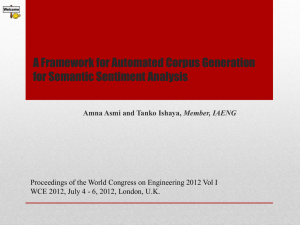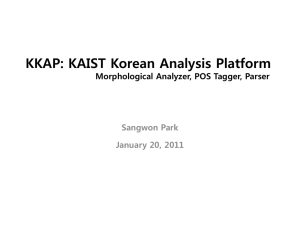Word alignment - Institute of Formal and Applied Linguistics
advertisement
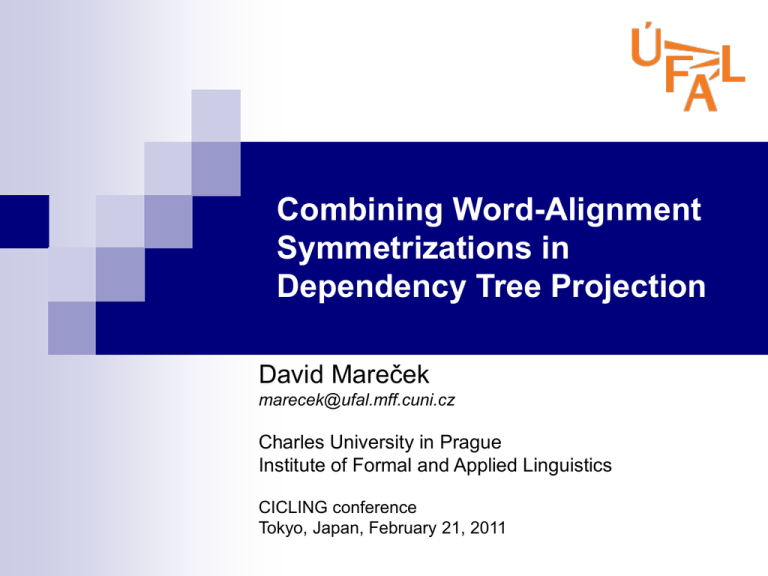
Combining Word-Alignment Symmetrizations in Dependency Tree Projection David Mareček marecek@ufal.mff.cuni.cz Charles University in Prague Institute of Formal and Applied Linguistics CICLING conference Tokyo, Japan, February 21, 2011 Motivation Let’s have a text in a language which is not very common... We would like to parse it, but we do not have any parser no manually annotated treebank But we do have a parallel corpus with another language English Our goal – To create a parser Take the parallel corpus with English Make a word-alignment on it GIZA++ Parse the English side of the corpus MST dependency parser Transfer the dependencies from English to the target language using the word-alignment Train the parser on the resulting trees Previous works Rebecca Hwa (2002, 2005) Simple algorithm for projecting trees from English to Spanish and Chinesse Only one type of alignment used and not specified which one K. Ganchev, J. Gillenwater, B. Taskar (2009) Unsuprevised parser with posterior regularization, in which inferred dependencies should correspond to projected ones English to Bulgarian Our contribution To show that utilization of various types of alignment improves the quality of dependency projection GIZA++ [Och and Ney, 2003] two uni-directonal asymmetric alignments symmetrization methods Simple algorithm for projecting dependencies using different types of alignment links Training and evaluating MST parser Word alignment GIZA++ toolkit has asymmetric output For each word in one language just one counterpart from the other language is found Coordination of fiscal policies indeed , can be counterproductive . Eine Koordination finanzpolitischer Maßnahmen kann in der Tat kontraproduktiv sein . ENGLISH-to-X Coordination of fiscal policies indeed , can be counterproductive . Eine Koordination finanzpolitischer Maßnahmen kann in der Tat kontraproduktiv sein . X-to-ENGLISH Symmetrization methods Combinations of previous two unidirectional alignments Coordination of fiscal policies indeed , can be counterproductive . Eine Koordination finanzpolitischer Maßnahmen kann in der Tat kontraproduktiv sein . INTERSECTION Coordination of fiscal policies indeed , can be counterproductive . Eine Koordination finanzpolitischer Maßnahmen kann in der Tat kontraproduktiv sein . GROW-DIAG-FINAL Which alignment to use for the projection? We have presented four different types of alignment ENGLISH-to-X, X-to-ENGLISH, INTERSECTION, GROW-DIAG-FINAL We prefer X-to-ENGLISH alignment we need to find a parent for each token in the language X we don’t mind English words that are not aligned We recognize three types of links A: links that appeared in INTERSECTION alignment (red) B: links that appeared in GROW-DIAG-FINAL and also in X-to-ENGLISH alignment (orange) C: links that appeared only in X-to-ENGLISH alignment (blue) Coordination of fiscal policies indeed , can be counterproductive . Eine Koordination finanzpolitischer Maßnahmen kann in der Tat kontraproduktiv sein . Algorithm - example Coordination of fiscal policies indeed , can be counterproductive . Eine Koordination finanzpolitischer Maßnahmen kann in der Tat kontraproduktiv sein . Results The best results for each of the testing languages: English parser trained on CoNLL-X data The projection was made on first 100.000 sentence pairs from Newscommentaries (or Acquis-communautaire) parallel corpus We used McDonald’s maximum spaning tree parser Language Parallel Corpus Testing Data Accuracy Bulgarian Acquis CoNLL-X 52.7 % Czech News CoNLL-X 62.0 % Dutch Acquis CoNLL-X 52.4 % German News CoNLL-X 55.7 % Why is the accuracy so low? Treebanks in CoNLL differ in annotation guidelines Different handling of coordination structures, auxiliary verbs, noun phrases, ... Comparison with previous work We have run our projection method on the same datasets as in the previous work by Ganchev et al. (2009) Bulgarian, OpenSubtitles parallel corpus English parser trained on PennTreebank Tested on Bulgarian CoNLL-X train sentences up to 10 words Method Parser Accuracy Ganchev et al. Discriminative model 66.9 % Ganchev et al. Generative model 67.8 % Our method MST parser 68.1 % Our results are slightly better we did NOT use any unsupervised inference of dependency edges we utilized better the word aligment Conclusions We proved that using combination of different word-alignment improves dependency tree projection We outperform the state-of-the art results The problem of testing is in a different anotation guidelines for each treebank Thank you for your attention

